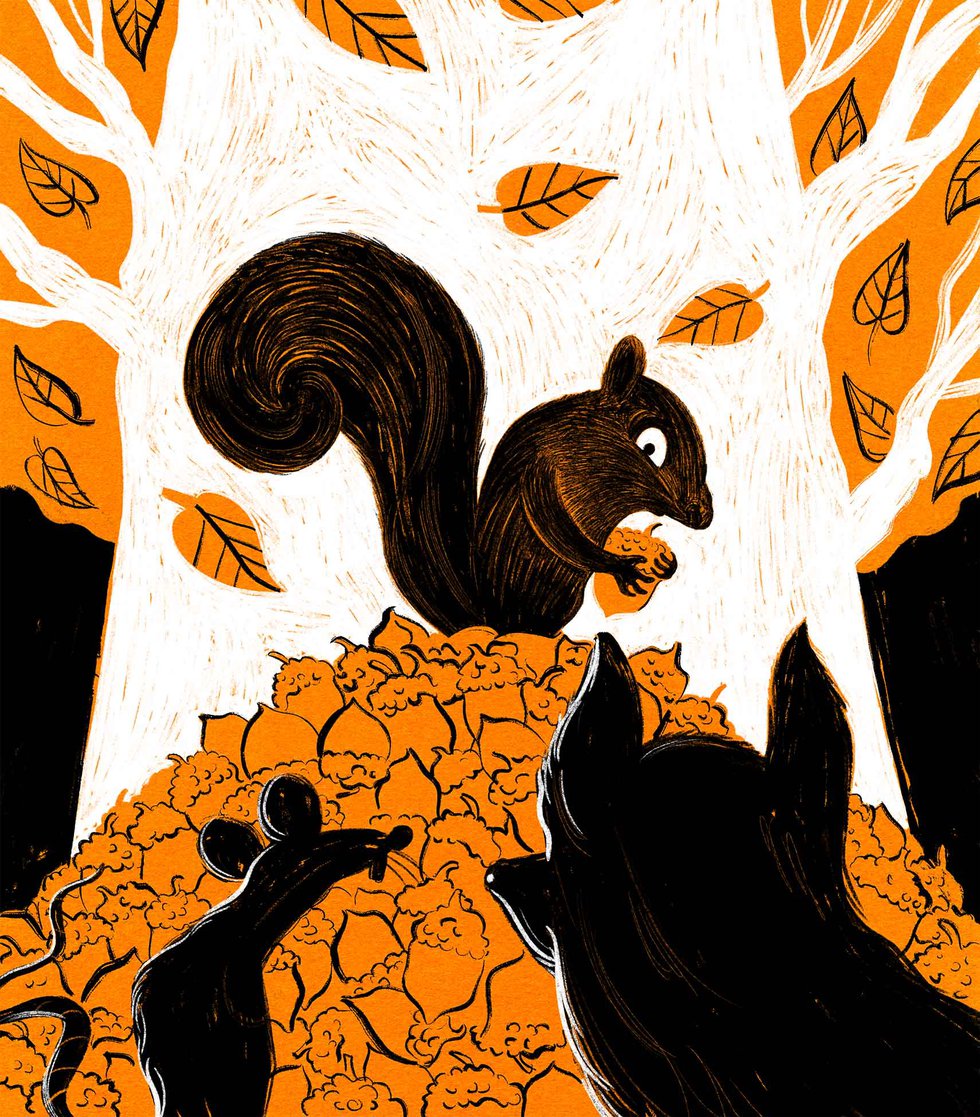It doesn’t take an etymologist to guess why the season after summer is commonly referred to as “fall.” It’s that time of year when it all comes down. Leaves fall. Temperatures fall. For those of us who need our daylight in big doses, spirits fall.
And of course, if you’ve got some big, old oak trees about, acorns fall.
A cascade, a deluge, an avalanche—in a boom acorn year, if you happen to live beneath one of those trees, every passing autumn breeze can unleash a veritable hailstorm on your rooftop.
Acorns are, of course, the fruit of oak trees. And they fall—of course—because tiny acorns/mighty oaks … you know the drill. Acorns are how oak trees make more oak trees.
But have you ever noticed how some years there are acorns everywhere, and some years they’re thin on the ground? Your impression is not wrong; oaks do indeed cycle through years of greater and lesser acorn production. “Mast” is the technical term for the fruit—whether nuts or berries—of forest trees and shrubs. And when, every few years, one of those fruiting woodland species produces a particularly over-abundant crop, it’s known as a “mast year.”

VL-FINAL-RGB✅
Different species of oak (there are about 90 native to North America) have different mast cycles, but perhaps the most fascinating thing about mast years is that the trees somehow manage to coordinate the phenomenon between themselves. This “synchrony” can apparently take place among trees spread across hundreds of miles or more.
Oaks need at least 20 years or longer to reach acorn-producing age, so it takes a pretty big oak to grow a really big acorn harvest. But in a mast year, one of those venerable 100-year-old oaks might produce as many as 10,000 acorns. One theory of mast years is that such a feast of plenty overwhelms even the hungriest hordes of wildlife, with the result that enough acorns go uneaten to seed a new generation of trees.
And what doesn’t eat acorns? Mice, deer, foxes, rabbits, squirrels, black bears, wild turkey—they’re all lining up for the buffet. They are the feast of the forest, the woodland answer to the question, “What’s for dinner?” And breakfast. And lunch. Even people can eat acorns, although if you don’t want to make yourself seriously sick, you first need to process them to leach out the high levels of tannins they contain. There are recipes online for acorn cake, acorn bread, acorn coffee, acorn brittle—you could pretty much make yourself an acorn meal if you were so inclined. You might not want, however, to partake on the ones the acorn weevils have already gotten to. (The reader who queried “What are those grubs crawling out of the acorns?” to a Pennsylvania outdoors columnist lived that experience so you don’t have to.)
Speaking of things you eat, you may have heard someone refer to an acorn as an “eggcorn.” Possibly, you’ve used the word yourself. Your author once heard an actual arborist use the word, and I cannot swear to you that he was being facetious. One theory has been ventured that eggcorn is a mashup of “oak” and “corn.” Another, that the (sort of) egg-like shape of an acorn is the inspiration for the word.
However “eggcorn” came to be, the word itself has taken on a new life beyond its oak-fruit origins. Just as a misheard lyric is known as a “mondegreen,” now “eggcorn” has come to stand for the entire delightful category of misheard words and phrases, like “holiday sauce” for “hollandaise,” “medium strip” for “median strip,” and “windshield factor” for that extra measure of cold that comes when the wind blows on winter days (that would be “wind chill factor”). “Eggcorn” was first proposed by linguist Geoffrey Pullum in the word-lover’s blog Language Log for what he called a “slip of the ear;” the Oxford English Dictionary (online) made that definition OED-official in 2010.
And now with eggcorn—or rather, acorn—season upon us again, you can not only help keep critters fed, but you can also help keep Virginia forested. Every year, the Virginia Department of Forestry asks landowners to gather nuts and acorns for planting at its Augusta Nursery in Crimora. The seedlings produced grow into tomorrow’s forests. So if you have acorn-producing oaks of your own after the mice and deer and squirrels have had their fill—whether pin oaks, willow oaks, white oaks, or chestnut oaks—think of them as a treasure trove to seed the future. DOF.Virginia.gov
Caroline Kettlewell is an insatiably curious writer who has a particular interest in stories about science, health, and the natural world. CarolineKettlewell.com








